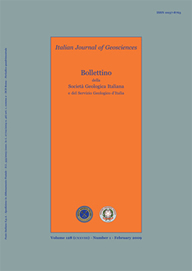
Facies associations of the late Cenomanian carbonate platform of Tripolitza subzone (Vitina, Central Peloponnesus, Greece): evidence of long-term/terrestrial subaerial exposure
F.A. Pomoni-Papaioannou(*) & A. Zambetakis-Lekkas(*)
(*) Department of Geology and Geoenvironment, Section of Historical Geology and Palaeontology, National University of Athens, Panepistimiopolis, 157 84 Athens, Greece. E-mail: fpomoni@geol.uoa.gr
Volume: 128 (2009) f.1
Pages: 123-130
Abstract
The facies distribution of the Late Cenomanian carbonate platform deposits of the Tripolitza zone, in central Peloponnesus (Vitina, Mainalon Mnt., Greece) is more or less uniform and supports a flat topography of the related platform sector during the above interval. Peritidal facies with shallow-upward cyclothems predominate, containing a subaerial exposure evidence, while parts of the studied section correspond to vanished evaporites. Texturally, the Late Cenomanian limestone in central Peloponnesus, as well as, in central eastern Crete, appear principally as wackestone, lesser as wackestone-packstone and only randomly as packstone-floatstone. Peloidal wackestone are common, as well, characterized by irregular fenestrae and/or dissolution cavities. Grainstone (intrabiopelsparites) are minor in occurrence.
Facies associations include: fossiliferous limestone/dolostone and microbial laminites documenting a low-energy, restricted shallow subtidal environment to intertidal/supratidal settings in a ramp-like depositional system comparable with the Balearic ramp-like platforms; temporary high-energy conditions also periodically instead of occured; dolomites/dedolomites after preexistent evaporites assigned to supratidal conditions and intermittent subaerial exposure as well as pedogenic limestone-conglomerates support a long-term, terrestrial exposure environment. The thick shale interval detected in the Vitina section supports a long-lasting exposure (sedimentary hiatus) of the platform during the Late Cenomanian. Pedogenic alteration of the sediments is intensive along certain horizons, indicating repeated sea-level fall intervals, supporting regional sea-level fluctuations, of allogenic origin, during a general sea-level rise status, which for the Late Cenomanian is known to coincide with the highest global sea-level stand.
Keywords
Get Full Text